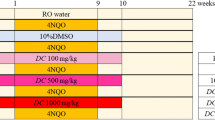Abstract
Olive leaf extract provides nutritional support for detoxification at the cellular level, when the body is under stress. The present study aimed to evaluate the chemopreventive effect of oleuropein-rich extract (ORE) on 4-NQO-induced rat tongue carcinogenesis. Eighty male F344 rats, 6 weeks age were divided into 5 groups (10 animals each for groups 1 and 2 and 20 each for groups 3, 4, and 5). Group 1 served as an untreated control. Group 2 was given ORE-containing diet alone. Rats of groups 3, 4, and 5 were given daily 20 ppm 4-NQO in drinking water for 8 weeks. Group 4 was fed diets containing ORE, concomitantly with the time of carcinogen exposure and continued 1 week after its stoppage. Group 5 was fed diets mixed with ORE starting 1 week after cessation of 4-NQO treatment. The experiment was terminated when the rats aged 37 weeks, and all animals were euthanized. The tongues were carefully inspected for pathological lesions, excised, and were processed for c-Met and Ki-67 immunohistochemical examination. The gross inspection, histopathological and immunohistochemical results of the present study showed a beneficial regression effect of ORE on tumor progression, especially when it was administered concomitantly with 4-NQO rather than when given after the stoppage of the carcinogenic material. In conclusion, ORE has a chemopreventive role in tongue squamous cell carcinoma, and further studies are needed to explore the molecular mechanisms of its tumor suppressive effect at this level.



Similar content being viewed by others
References
Pisani P, Bray F, Parkin DM. Estimates of the world-wide prevalence of cancer for 25 sites in the adult population. Int J Cancer. 2002;97:72–81.
Silverman S Jr. Demographics and occurrence of oral and pharyngeal cancers. The outcomes, the trends, the challenge. J Am Dent Assoc. 2001;32(Suppl):7S–11S.
Wallenius K, Lekholm U. Oral cancer in rats induced by the water-soluble carcinogen 4-nitrochinoline N-oxide. Odontol Revy. 1973;24:39–48.
Tanaka T, Kojima T, Okumura A, Yoshimi N, Mori H. Alterations of the nucleolar organizer regions during 4-nitroquinoline 1-oxide-induced tongue carcinogenesis in rats. Carcinogenesis. 1991;2:329–33.
Desai AG, Qazi GN, Ganju RK, El-Tamer M, Singh J, Saxena AK, Bedi YS, Taneja SC, Bhat HK. Medicinal plants and cancer chemoprevention. Curr Drug Metab. 2008;9:581–91.
Espìn JC, Garcìa-Conesa MT, Tomás-Barberán FA. Nutraceuticals: facts and fiction. Phytochemistry. 2007;68:2986–3008.
Tabera J, Guinda A, Ruiz-Rodríguez A, Señoráns FJ, Ibáñez E, Albi T, Reglero G. Countercurrent supercritical fluid extraction and fractionation of high-added-value compounds from a hexane extract of olive leaves. J Agric Food Chem. 2004;52:4774–9.
El SN, Karakaya S. Olive tree (Olea europaea) leaves: potential beneficial effects on human health. Nutr Rev. 2009;67:632–8.
Briante R, Patumi M, Terenziani S, Bismuto E, Febbraio F, Nucci R. Olea europaea L. leaf extract and derivatives: antioxidant properties. J Agric Food Chem. 2002;50:4934–40.
Hou XZ, Liu W, Fan HT, Liu B, Pang B, Xin T, Xu SC, Pang Q. Expression of hepatocyte growth factor and its receptor c-Met in human pituitary adenomas. Neuro Oncol. 2010 Mar 3. [Epub ahead of print].
Salvesen HB, Iversen OE, Akslen LA. Prognostic significance of angiogenesis and Ki-67, p53, and p21 expression: a population-based endometrial carcinoma study. J Clin Oncol. 1999;17:1382–90.
Jemai H, Bouaziz M, Fki I, El Feki A, Sayadi S. Hypolipidimic and antioxidant activities of oleuropein and its hydrolysis derivative-rich extracts from Chemlali olive leaves. Chem Biol Interact. 2008;176:88–98.
Yoshida K, Tanaka T, Hirose Y, Yamaguchi F, Kohno H, Toida M, Hara A, Sugie S, Shibata T, Mori H. Dietary garcinol inhibits 4-nitroquinoline 1-oxide-induced tongue carcinogenesis in rats. Cancer Lett. 2005;221:29–39.
Koul A, Mukherjee N, Gangar SC. Inhibitory effects of Azadirachta indica on DMBA-induced skin carcinogenesis in Balb/c mice. Mol Cell Biochem. 2006;283:47–55.
Tanaka T. Chemoprevention of oral carcinogenesis. Eur J Cancer B Oral Oncol. 1995;31B:3–15.
Kitano M. Host genes controlling the susceptibility and resistance to squamous cell carcinoma of the tongue in a rat model. Pathol Int. 2000;50:353–62.
Miljković D, Dekanski D, Miljković Z, Momcilović M, Mostarica-Stojkovic M. Dry olive leaf extract ameliorates experimental autoimmune encephalomyelitis. Clin Nutr. 2009;28:346–50.
Abaza L, Talorete TP, Yamada P, Kurita Y, Zarrouk M, Isoda H. Induction of growth inhibition and differentiation of human leukemia HL-60 cells by a Tunisian gerboui olive leaf extract. Biosci Biotechnol Biochem. 2007;71:1306–12.
Sudjana AN, D’Orazio C, Ryan V, Rasool N, Ng J, Islam N, Riley TV, Hammer KA. Antimicrobial activity of commercial Olea europaea (olive) leaf extract. Int J Antimicrob Agents. 2009;33:461–3.
Lo Muzio L, Farina A, Rubini C, Coccia E, Capogreco M, Colella G, Leonardi R, Campisi G, Carinci F. Effect of c-Met expression on survival in head and neck squamous cell carcinoma. Tumour Biol. 2006;27:115–21.
Lavelli V. Comparison of the antioxidant activities of extra virgin olive oils. J Agric Food Chem. 2002;50:7704–8.
Visioli F, Galli C, Plasmati E, Viappiani S, Hernandez A, Colombo C, Sala A. Olive phenol hydroxytyrosol prevents passive smoking-induced oxidative stress. Circulation. 2000;102:2169–71.
Hamdi HK, Castellon R. Oleuropein, a non-toxic olive iridoid, is an anti-tumor agent and cytoskeleton disruptor. Biochem Biophys Res Commun. 2005;334:769–78.
Han J, Talorete TP, Yamada P, Isoda H. Anti-proliferative and apoptotic effects of oleuropein and hydroxytyrosol on human breast cancer MCF-7 cells. Cytotechnology. 2009;59:45–53.
Wlodek L, Steven HZ. Antioxidants, programmed cell death, and cancer. Nutr Res. 2001;21:295–307.
Author information
Authors and Affiliations
Corresponding author
Rights and permissions
About this article
Cite this article
Grawish, M.E., Zyada, M.M. & Zaher, A.R. Inhibition of 4-NQO-induced F433 rat tongue carcinogenesis by oleuropein-rich extract. Med Oncol 28, 1163–1168 (2011). https://doi.org/10.1007/s12032-010-9612-2
Received:
Accepted:
Published:
Issue Date:
DOI: https://doi.org/10.1007/s12032-010-9612-2




